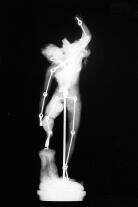Iron-induced structural rearrangements and their impact on sulfur solubility in borosilicate-based nuclear waste glasses
Résumé
The work presented in the article combines the strength of experimental and computational materials science to understand the iron (Fe 2 O 3 ≤ 3 mol.%) -induced structural rearrangements in peralkaline aluminoborosilicate glasses and their impact on the solubility of sulfur (as SO 4 2-) in the model nuclear waste glasses. The majority (>95%) of iron exists as tetrahedrally coordinated Fe 3+ (both isolated and clustered) in the investigated glasses, thus acting as a network former being charge compensated by Na + , while the remaining exists as tetrahedrally (distorted) coordinated Fe 2+ . The addition of iron induces re-polymerization in the glass network, thus lowering the sulfur solubility in the glassy matrix. Mössbauer spectroscopy reveals an insignificant impact of sulfur on the redox behavior or environment of iron in the glass structure.
Domaines
Planète et Univers [physics]| Origine | Fichiers produits par l'(les) auteur(s) |
|---|


